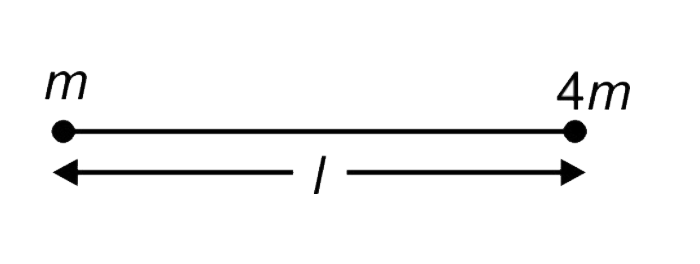Two particles A and B having masses M and 4M respectively are kept at a distance 2.73 m apart. Another small particle of mass m is to be placed so that the net gravitational force on it is zero. What will be its distance from body A ?
To solve the problem, we need to find the distance from particle A where a small particle of mass m can be placed such that the net gravitational force acting on it is zero. Here’s a step-by-step solution:
Step 1: Understand the Setup
We have two masses:
- Mass M (particle A)
- Mass 4M (particle B)
These two masses are separated by a distance of 2.73m.
Step 2: Define the Position of the Small Mass
Let the small mass m be placed at a distance x from particle A. Consequently, the distance from particle B will be 2.73−x.
Step 3: Write the Gravitational Forces
The gravitational force exerted on mass m by mass M (particle A) is given by:
FA=GMmx2
The gravitational force exerted on mass m by mass 4M (particle B) is given by:
FB=G(4M)m(2.73−x)2
Step 4: Set the Forces Equal
For the net gravitational force on mass m to be zero, the forces must be equal:
FA=FB
This gives us the equation:
GMmx2=G(4M)m(2.73−x)2
Step 5: Simplify the Equation
We can cancel G and m from both sides:
Mx2=4M(2.73−x)2
Now, cancel M (assuming M≠0):
1x2=4(2.73−x)2
Step 6: Cross Multiply
Cross multiplying gives:
(2.73−x)2=4x2
Step 7: Expand and Rearrange
Expanding the left side:
2.732−2⋅2.73⋅x+x2=4x2
Rearranging gives:
2.732−2⋅2.73⋅x+x2−4x2=0
This simplifies to:
2.732−2⋅2.73⋅x−3x2=0
Step 8: Solve the Quadratic Equation
This is a quadratic equation in the form ax2+bx+c=0:
−3x2−2⋅2.73⋅x+2.732=0
Using the quadratic formula x=−b±√b2−4ac2a:
- a=−3
- b=−2⋅2.73
- c=2.732
Calculating the discriminant:
b2−4ac=(−2⋅2.73)2−4⋅(−3)⋅(2.732)
Solving this will yield the values for x.
Step 9: Find the Value of x
After solving, we find:
x=0.91m
Final Answer
The distance from body A where the small mass m should be placed is 0.91m.
---
We have two masses:
- Mass M (particle A)
- Mass 4M (particle B)
Let the small mass m be placed at a distance x from particle A. Consequently, the distance from particle B will be 2.73−x.
The gravitational force exerted on mass m by mass M (particle A) is given by:
FA=GMmx2
The gravitational force exerted on mass m by mass 4M (particle B) is given by:
FB=G(4M)m(2.73−x)2
For the net gravitational force on mass m to be zero, the forces must be equal:
FA=FB
This gives us the equation:
GMmx2=G(4M)m(2.73−x)2
We can cancel G and m from both sides:
Mx2=4M(2.73−x)2
Now, cancel M (assuming M≠0):
1x2=4(2.73−x)2
Cross multiplying gives:
(2.73−x)2=4x2
Expanding the left side:
2.732−2⋅2.73⋅x+x2=4x2
Rearranging gives:
2.732−2⋅2.73⋅x+x2−4x2=0
This simplifies to:
2.732−2⋅2.73⋅x−3x2=0
This is a quadratic equation in the form ax2+bx+c=0:
−3x2−2⋅2.73⋅x+2.732=0
Using the quadratic formula x=−b±√b2−4ac2a:
- a=−3
- b=−2⋅2.73
- c=2.732
b2−4ac=(−2⋅2.73)2−4⋅(−3)⋅(2.732)
Solving this will yield the values for x.
After solving, we find:
x=0.91m
The distance from body A where the small mass m should be placed is 0.91m.
Topper's Solved these Questions
- BOOK - DC PANDEY ENGLISHCHAPTER - GRAVITATIONEXERCISE - Solved Examples16videos
GRAVITATION
- BOOK - DC PANDEY ENGLISHCHAPTER - GRAVITATIONEXERCISE - Miscellaneous Examples8videos
GRAVITATION
- BOOK - DC PANDEY ENGLISHCHAPTER - GENERAL PHYSICSEXERCISE - INTEGER_TYPE2videos
GENERAL PHYSICS
- BOOK - DC PANDEY ENGLISHCHAPTER - KINEMATICSEXERCISE - INTEGER_TYPE10videos
KINEMATICS
Similar Questions
Two bodies A and B having masses M and 3M respectively are kept at a distance 2.73 m apart. A small particle of mass m is to be place so that the net gravitational force on it, due to A and B is zero. What will be its distance from body A ?
View SolutionTwo bodies of mass M and 4M kept at a distance y apart. Where should a small particle of mass m be placed from M so that the net gravitational force on it is zero
View Solution
Knowledge Check
- Question 1 - Select One
The reduce mass of two particles having masses m and 2 m is
A2 mB3 mC2 m/3Dm/2
Two point masses m and 4 m are seperated by a distance d on a line . A third point mass m0 is to be placed at a point on the line such that the net gravitational force on it zero .

The distance of that point from the m mass isView SolutionTwo spheres of masses 16 kg and 4 kg are separated by a distance 30 m on a table. Then, the distance from sphere of mass 16 kg at which the net gravitational force becomes zero is
View SolutionIn the figure given below, two particles of masses m and 2m are fixed in place on an axis. Where on the axis can a third particle of mass 3m be placed (other than at infinity) so that the gravitational force on it from the first two particles is zero?
 View Solution
View SolutionTwo bodies of masses m and 4m are placed at a distance r. The gravitational potential at a point due to mass m on the line joining where gravitational field is zero
View SolutionTwo small bodies of masses 2.00 kg and 4.00 kg are kept at rest at a separation of 2.0 m. Where should a particle of mass 0.10 kg be placed to experience no net gravitational force from these bodies? The particle is placed at this point. What is the gravitational potential energy of the system of three particle with usual reference level?
View SolutionTwo bodies of masses m1 and m2 are placed distant d apart. Show that the position where the gravitational field due to them is zero, the potential is given by, V=−Gd(m1+m2+2√m1m2)
View SolutionTwo particles having masses m and 4m are separated by distance l. The distance of the centre of mass from m is x1andx2 is the distance of point at which gravitational field intensity is zero. Find the value of x1x2
 View Solution
View Solution

